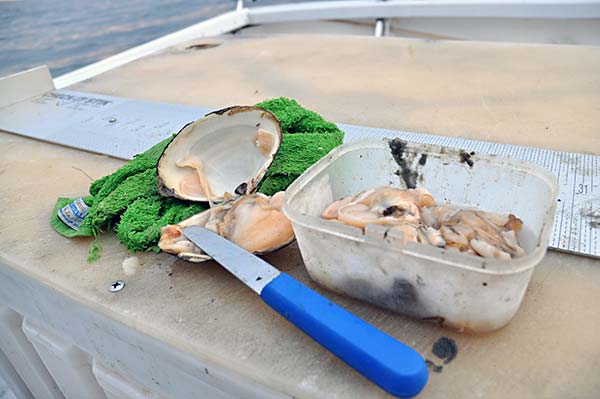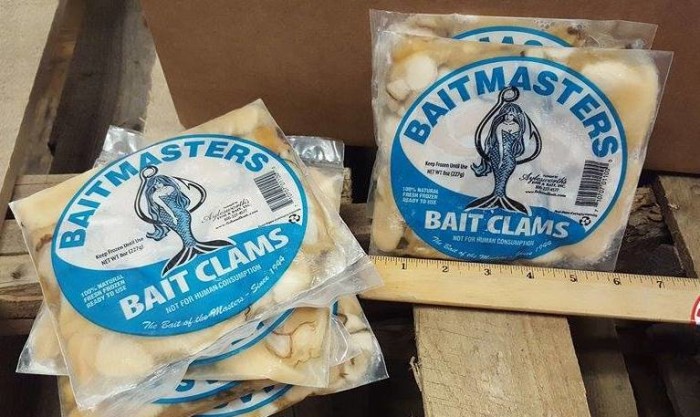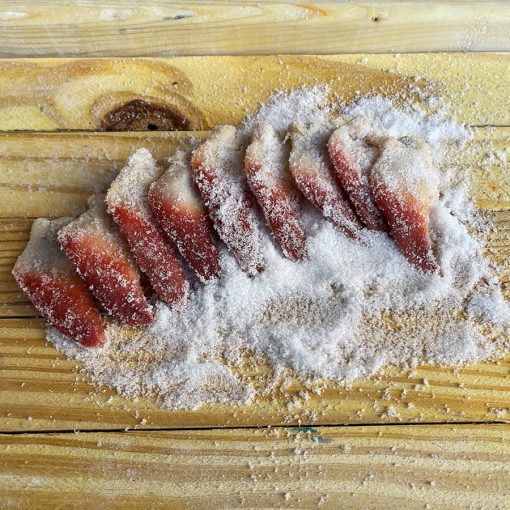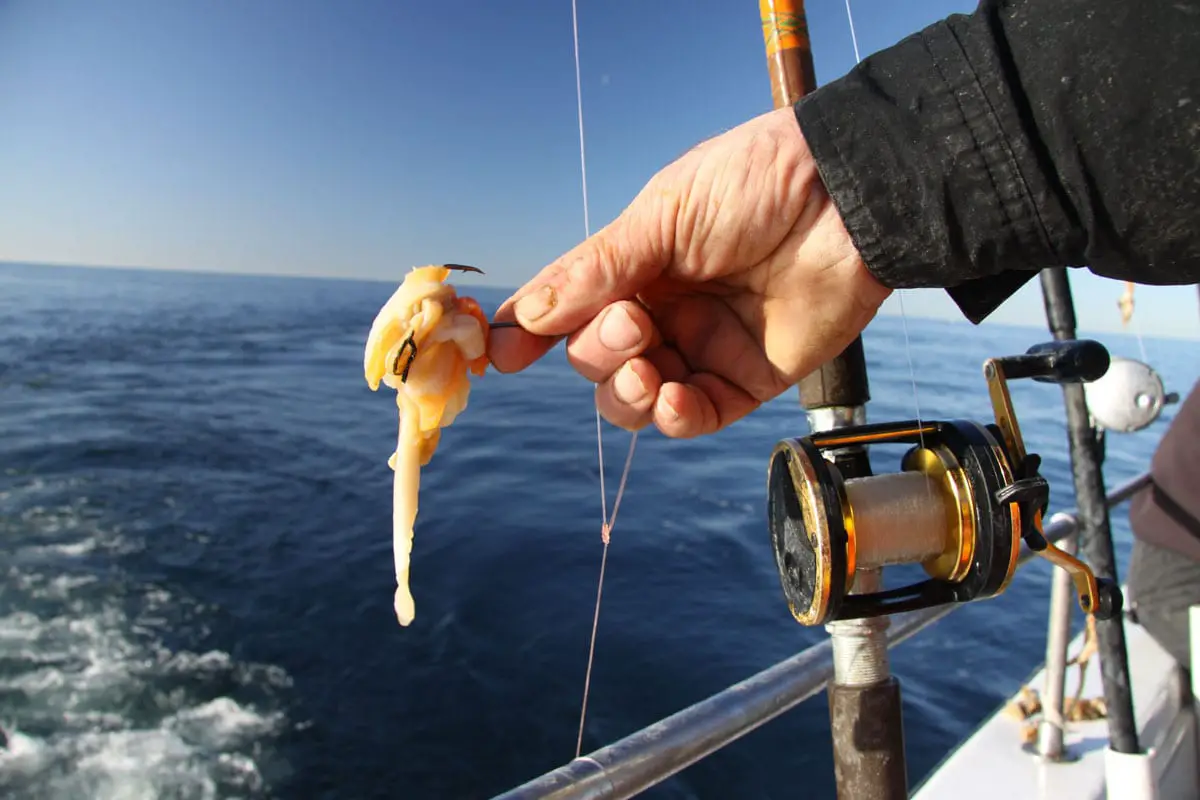If you are a saltwater fisherman on the East Coast then you know what’s coming soon after a drop in water temperature, Stripe Bass will be showing up in the tidal rivers and bays along with the coastline beaches and estuaries where their seasonal migration turns on. One of the best natural baits to use for striped bass fishing among other saltwater predator fish is clam which can sometimes be difficult to use. What is the best way to fish with clams?
Clam bait comes as frozen, fresh shuck, & salted which are best fished on circle hooks by threading the Clam onto a hook, starting with the soft “belly” and ending with the more muscular foot, wrapped with elastic thread that will keep soft bait in place while casting & from smaller bait-stealers.
Understanding some of the basics of using clams as a go-to bait and learning some simple fishing tips can get you the results you are looking for no matter the location saltwater or even freshwater.
Fishing With Clams
When fishing with clams, here’s a list of items you might need:
- Clams: Fresh or preserved clams are the primary bait for fishing. Choose the appropriate size and type of clam based on the fish you’re targeting.
- Bait Knife: A sharp bait knife is essential for cutting and preparing the clams for baiting your hooks.
- Bucket or Cooler: Use a bucket or cooler to keep your clams fresh and easily accessible while fishing.
- Bait Bag or Container: A bait bag or container helps keep your clams secure and prevents them from washing away or attracting unwanted attention from other marine creatures.
- Rod and Reel: Choose the appropriate rod and reel setup based on the type of fishing you’ll be doing and the size of the fish you’re targeting.
- Terminal Tackle: This includes hooks, sinkers, swivels, and leaders suitable for the type of fishing you’ll be doing and the species of fish you’re targeting.
- Fishing Line: Spool your reel with the appropriate fishing line based on the fishing conditions and the size of the fish you expect to catch.
- Fishing License: Make sure you have a valid fishing license for the area where you’ll be fishing, as regulations vary by location.
- Optional Extras: Depending on your preferences and fishing style, you may also want to bring items such as a tackle box, fishing gloves, sunscreen, sunglasses, and a hat for sun protection.
By having these items on hand when fishing with clams, you’ll be well-prepared for a successful and enjoyable fishing experience.
Atlantic surf clams are available species along the western North Atlantic Ocean from southern Canada down to Cape Hatteras, North Carolina. Clam as bait comes as:
- Frozen
- Shuck Clams
- Salted
Bait & Tackle fishing shops sell clams by the individual clam, half-bushel, and full-bushel in order to cater to the various anglers that end up in their store. Frozen Clams are held in refrigerated boxes with other frozen bait fish.
Fresh Shucked clams are the most popular bait for serious angler fishing in many different varieties of fish. They are very good bait with pier, bridge, or surf fishermen. The shucked surf clams are tough bait for the discerning fisherman. Clams are known most famously for their use as a desired go-to bait for successfully catching Striped Bass, especially after a storm.
Large predatory fish, like a Striped Bass, swim these waters just off the beach in the Northeast part of the US to take advantage of the abundance of these shellfish. Clams are available in any Tackle and Bait shop along the ocean.
However, plenty of other fish will also bite a clam on a hook, such as Fluke, Flounder, Sea Robin, Bluefish, Sea Trout, Blackfish, Sea Bass, Porgy, Whiting, Rockfish, Surf Perch, and many types of Sharks. Clam bellies have a distinct taste and smell compared to most other forms of bait that are desirable to predator fish. Sea Clams normally come whole and are very durable bait and can be refrozen with no issues.
When fishing with clams, here’s a list of items you might need:
- Clams: Fresh or preserved fishing clams are the primary bait for fishing. Choose the appropriate size and type of clam based on the fish you’re targeting.
- Bait Knife: A sharp bait knife is essential for cutting and preparing the clams for baiting your hooks.
- Bucket or Cooler: Use a bucket or cooler to keep your clams fresh and easily accessible while fishing.
- Bait Bag or Container: A bait bag or container helps keep your clams secure and prevents them from washing away or attracting unwanted attention from other marine creatures.
- Rod and Reel: Choose the appropriate rod and reel setup based on the type of fishing you’ll be doing and the size of the fish you’re targeting.
- Terminal Tackle: This includes hooks, sinkers, swivels, and leaders suitable for the type of fishing you’ll be doing and the species of fish you’re targeting.
- Fishing Line: Spool your reel with the appropriate fishing line based on the fishing conditions and the size of the fish you expect to catch.
- Fishing License: Make sure you have a valid fishing license for the area where you’ll be fishing, as regulations vary by location.
- Optional Extras: Depending on your preferences and fishing style, you may also want to bring items such as a tackle box, fishing gloves, sunscreen, sunglasses, and a hat for sun protection.
By having these items on hand when fishing with clams, you’ll be well-prepared for a successful and enjoyable fishing experience.
 Some fishermen don’t like using them because it’s tough to keep them on the hook. The truth is Shuck Clams fresh and in the shell are the most popular bait for serious fishermen. The scent and oils move through the water and will entice the most finicky predatory fish.
Some fishermen don’t like using them because it’s tough to keep them on the hook. The truth is Shuck Clams fresh and in the shell are the most popular bait for serious fishermen. The scent and oils move through the water and will entice the most finicky predatory fish.
They consider fresh clam like candy and will slam down on it. If you are using fresh clams, the meat will stay on the hook better. Once clams die, the meat deteriorates quickly and it will be hard to keep the bait on the hook.
As with any bait, fresh is always the best. Buy the clams in the shells and shuck each one just before baiting up. If fresh clams are unavailable, salted is a distant second-best but most agree fresher is better and in the end more successful.
Shucked clam bait in the shell can be priced per clam, by the pound, and by the bushel. A common price that we see in the New York & New Jersey area is around $0.75 per clam, $7.50 per pound & $75.00 per bushel, of salted or fresh clams. Clams can also be sold for chumming.
How to Catch Clams for Bait
Clams can be found just below the sand along the beaches. Some clams may be just a few inches below the surface while others may be over a foot deep. There are several ways to dig them up and they all work. Finding them can be tricky, but once you find them, you can usually dig some up for bait. If you have a hard time catching them, there are several places where you can buy clams for bait too.
Catching clams for bait can be a fun and rewarding activity, especially if you’re planning a fishing trip. Here’s a basic guide on how to catch clams for bait:
- Check Local Regulations: Before you start clamming, make sure to check the local regulations and obtain any necessary permits or licenses required for harvesting clams in your area. Regulations can vary by location and may include restrictions on the type of clams you can harvest, size limits, and harvesting seasons.
- Choose the Right Location: Look for sandy or muddy areas along the shoreline where clams are likely to be found. Clams are often found in shallow waters near the shore, especially in areas with a mix of sand and mud.
- Tools and Equipment: You’ll need some basic tools and equipment for clamming. These may include a clam rake, clam gun, or even just a sturdy shovel or garden fork. A bucket or mesh bag to hold your clams is also essential.
- Low Tide: Plan your clamming trip around low tide, as this will expose more of the clam beds and make it easier to spot and collect clams. Check tide charts for your area to determine the best time to go clamming.
- Spotting Clams: Look for signs of clam beds, such as small holes or depressions in the sand or mud. Once you’ve located a potential clam bed, use your tool to gently probe the sand or mud and feel for clams beneath the surface.
- Digging Clams: Use your clam rake, clam gun, or shovel to carefully dig around the clam and loosen it from the surrounding sediment. Be gentle to avoid damaging the clam’s shell. Once you’ve exposed the clam, reach down and carefully remove it from the sediment.
- Handle with Care: Handle the clams carefully to avoid damaging them. Place them directly into your bucket or mesh bag to keep them alive and fresh.
- Safety Considerations: Be mindful of your surroundings and any potential hazards while clamming, such as sharp rocks, strong currents, or slippery terrain. Wear appropriate footwear and dress for the weather conditions.
- Limit and Respect: Only take the number of clams you need for bait, and be sure to respect any size or quantity limits set by local regulations. Leave smaller clams and any clams that appear to be damaged or diseased to help sustain the clam population.
- Cleaning and Storage: Once you’ve finished clamming, rinse the clams thoroughly with clean water to remove any sand or debris. Store them in a cool, damp environment until you’re ready to use them as bait.
By following these steps and exercising care and caution, you can enjoy a successful clamming trip and collect fresh bait for your next fishing adventure.
Keeping Frozen Clam on the Hook in the Surf
Clams are one of the favorite baits on the eastern shore of the United States. Excellent bait for surf fishing. Best used to catch striped bass, flounder, trout, sheepshead, tautog, pompano, redfish, and drum. Where I fish on the Jersey coast clams come in a few different ways. Surf clams have been used for food as well as bait for at least 100 years.
 Frozen Clam is easier to handle as long as it stays frozen. They are sold in vacuum-type plastic sealed bags or frozen sales tubs or canisters that are fairly easy to use. Shuck Clams are best to use in any situation. Most striper fishermen agree that this method for fishing with clams is the best way. Buy the fresh live clams in the shells and shuck each one just before baiting when you get out on the beach into the elements.
Frozen Clam is easier to handle as long as it stays frozen. They are sold in vacuum-type plastic sealed bags or frozen sales tubs or canisters that are fairly easy to use. Shuck Clams are best to use in any situation. Most striper fishermen agree that this method for fishing with clams is the best way. Buy the fresh live clams in the shells and shuck each one just before baiting when you get out on the beach into the elements.
Live Clams are best fished on circle hooks, as even small stripers will quickly swallow them. Thread them onto the hook, starting with the soft “belly” and ending with the more muscular foot. A few wraps of elastic Clam Thread will keep the soft bait in place when casting out and help it resist smaller bait-stealers like crabs and baitfish for fishing that won’t leave it alone.
Avoid pulling your line in too many times and recasting. One thing for certain when using Clam for fishing is that the fresher the clam is, the easier it is to keep on your hook. As soon as the clam dies, that would be the ideal time to replace the clam meat on your hook.
Try and use the whole Frozen Clam because if the bait is too small, it won’t carry as much flavor from its oil and scent that will entice a bite from a Striper. Stripers love fresh rig clams, shucked clams, and salted clams. The juicier the clams, the better. Stripers love fresh clams, shucked clams, and salted clams. The juicier the clam, the fresher it is so it is worth the extra effort to shuck the clams and attach them to the hook. So even though frozen Clams may be easier to handle it is the fresh Shuck live Clams that big fish like and the Stripers crave.
To keep frozen clam on the hook in the surf, consider these tips:
- Thaw Partially: Thaw the frozen clam partially before use. This makes it easier to secure to the hook and reduces the risk of it falling off during casting.
- Use Mesh or Cloth: Wrap the partially thawed clam in a small piece of mesh or cloth. This helps hold the clam in place on the hook and prevents it from breaking apart when cast into the surf.
- Secure with Bait Thread: Use bait thread or elastic thread to securely wrap the clam to the hook. This provides extra stability and ensures the clam stays on the hook even in rough surf conditions.
- Add Natural Scent: Consider fishing by adding natural scents or attractants to the clam to enhance its appeal to fish. This can be done by soaking the clam in fish oil or applying a fish scent spray before baiting the hook.
- Use Barbed Hooks: Opt for barbed hooks, which can help hold the clam in place more effectively than barbless hooks, especially in turbulent surf.
- Monitor and Adjust: Keep an eye on your bait while fishing in the surf. If you notice the clam has become dislodged or damaged, replace it promptly to maintain its effectiveness as bait.
By following these tips, you can increase the likelihood of keeping frozen clam on the hook while fishing in the surf and attract more fish to your line.
Fishing Salted Rig Clams for Surf Fishing
For surf fishing with salted rig clams, begin by threading the salted clam onto your fishing rod securely. Cast your fishing line into the surf, ensuring it reaches areas where fish are likely to be feeding. Monitor your line closely for any bites or activity and be prepared to adjust your bait presentation or rod location accordingly to maximize your chances of catching fish.
(If fresh Clams in shells) are unavailable to you, using Salted clams is a distant second best. Bait Clams are salted for a few different reasons making Salted clams a viable and dependable alternative to using Fresh Bait Clams. If you don’t live near a Bait n Tackle store in order to get the real thing.
- It is easier to get on the hook
- Salted Clams will stay on the hook longer
- Will keep unrefrigerated or refrigerated and last longer
- Attracts fish with natural scent and flavor
- It won’t stink
- Small fish and crabs won’t be able to pull this bait off the hook

Mess-free clams that are hand-salted in a special dry brine mixture. All the natural scents of a real clam are preserved within this dry-salted version. As soon as the clam hits the water, it starts to take in moisture again and release a cloud of clammy scent!
Salted Clam Bait usually comes in packs with 7-9 freshly salted clams, the ones in a special individual salt mixture. What is nice is that the salt prevents the clams from freezing and just makes them like rubber. Use this size whole for big fish or cut them smaller.
Nothing beats fresh clam and rubber bands, one of the best baits. The second, to that, is salted clam, then cut into strips with no need for rubber bands. Salt cannot have iodine in it as it fowls the clam. Use kosher or sea salt. I use salt that is for saltwater aquaria as that is another hobby of mine and it works great. The same applies to squid. If you want to salt your own bait and a lot of fishermen do check out the video!
These are mess-free clams that we hand-salt in a special dry brine mixture. All the natural scents of a real clam are preserved within this dry-salted version. As soon as the clam hits the water, it starts to take in moisture again and release a cloud of clammy scent!
You can order these Real Bait Real Tough baits online for around $18.50 Bait will naturally vary in color and size. Bait is packaged with an additional salt preservation mixture. Value Pack- Clammy Bits- Salted Clam- Fishing Bait by Hey Skipper
Conclusion:
Use Fresh Clam bait (fresh Clams in shells) if this is unavailable to you, using Salted clams are a distant second best frozen, & salted which are best fished on circle hooks by threading the Clam onto a hook, starting with the soft “belly” and ending with the more muscular foot, wrapped with elastic thread that will keep soft bait in place while casting & from smaller bait-stealers in the surf.
Having fished with clams on the surf in New Jersey Clams are best for Striper but you need to bait your hook while still frozen and then tie the clam to a circle hook with the elastic band that is sold with the bait at the Bait and Tackle stores

References:
On the Water- Catching Early Striper with Clams
FAQ’s
